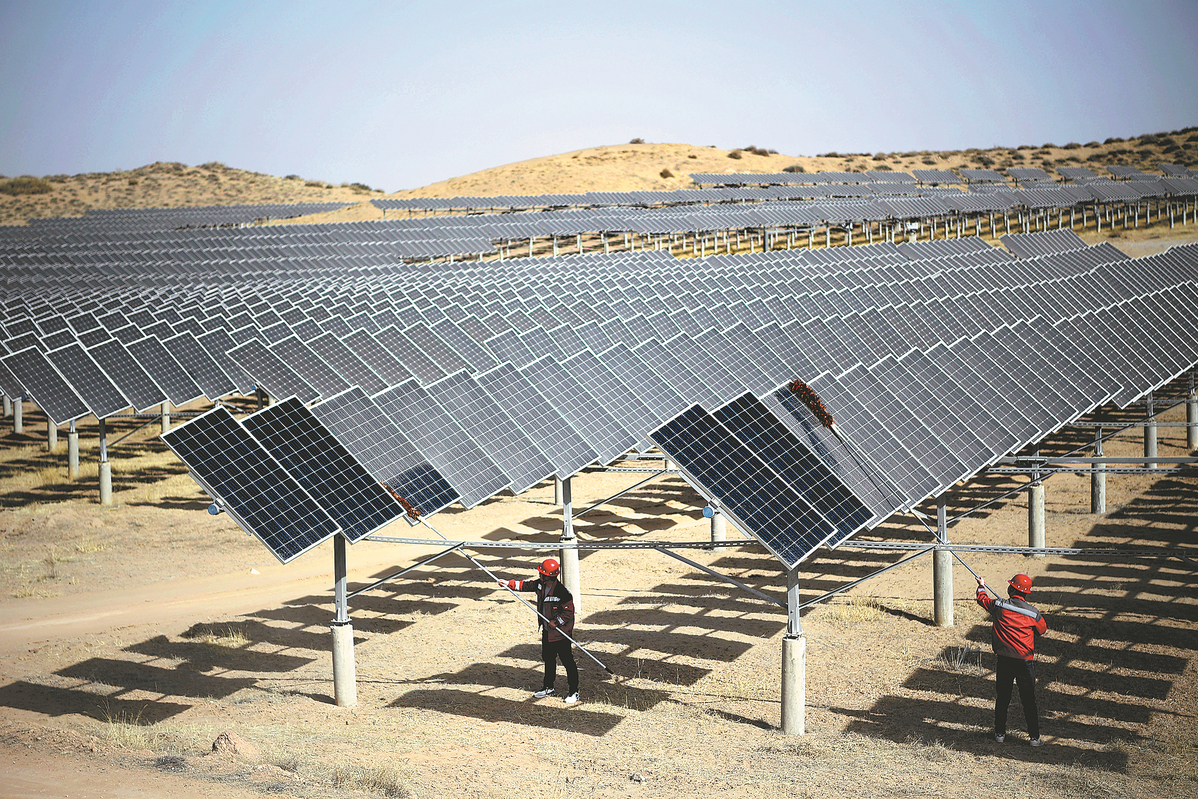Technicians carry out maintenance work on photovoltaic panels at a solar power plant in Yinchuan, Ningxia Hui autonomous region, in March. [Photo/Xinhua]
Proportion of country's clean electricity expected to reach 70 percent of total terminal consumption by 2060.
While China has come up with the world's largest power grid, its power sector needs further reform to ensure sufficient power supplies amid the country's green transition, industry experts said.
China's power market, after more than two decades of reform, boasts the world's largest installed capacity — twice that of the United States. However, diversified moves are still necessary to further facilitate the large-scale application of clean energy nationwide, said Shu Yinbiao, president of the International Electrotechnical Commission as well as an academician at the Chinese Academy of Engineering.
The proportion of China's green electrical energy is expected to reach 70 percent of the country's total terminal energy consumption by 2060, compared with its current green electrification rate of 27 percent, which is still 5 percent higher than the global average, Shu said during a high-end power market forum held by the China Electricity Council in Beijing recently.
Transformation of the power sector plays a critical role in facilitating the government's ambition to achieve carbon neutrality by 2060, he said
The electrification rate refers to the proportion of electricity consumption by all sectors of the national economy and people's daily lives, and its improvement will help reduce pollutants and develop energy utilization efficiency
China has been vigorously facilitating the replacement of coal and oil with electricity in the fields of industry, transportation, construction and agriculture as well as in rural areas, aiming to build a new type of power system featuring a gradual increase in the proportion of new energy resources and promoting the large-scale optimization of clean power resources
The National Energy Administration began soliciting public opinion on the development of the country's new type of power system in January. In a blue book released by the administration, it emphasizes the importance of making new energy resources a reliable alternative to their traditional peers.
It also vows to further step up the integrated development of power generation, the grid network and energy storage, in addition to research on clean energy resource evaluation and power prediction technology.
Shu added that non-fossil energy now accounts for around 15 percent of total energy consumption, still a long way from its target of having 80 percent of its total energy mix from non-fossil fuel sources by 2060, according to a high-level policy framework for achieving peak carbon and carbon neutrality published by the State Council, the country's Cabinet.
Shu said more efforts should be made to improve the energy price mechanism as well as accelerate the deep integration of electrification, digitalization and informatization to comprehensively elevate the intelligent and efficient level of terminal energy consumption.
"China has come up with the world's largest clean energy system with record highs in the amount of electricity traded and the number of market players during the past two decades, while the rapid development of the power industry has also facilitated the nationwide application of new energies at the same time," he said
"For the years to come, it is necessary to strengthen subsidized purchases of new energy sources and come up with incentive policies and market mechanisms to promote a high proportion of new energy consumption and high-level development," he added
Employees from State Grid Corp of China use a helicopter to maintain an ultra-high voltage power transmission line in Huzhou, Zhejiang province, on April 8. [TAN YUNFENG/FOR CHINA DAILY]
Shu also emphasized the importance of the use of long-term power contracts in supporting the sustained expansion of renewables, adding that sustained development of renewables also requires a combination of localized projects and West-to-East power transmission
For the power market in China, enlarging power balancing areas and establishing market-based dispatch play an important role in optimizing grid operation for renewables integration, he said
Meanwhile, Shu said it is as important to give full play to the role of coal power as a cornerstone in China's energy mix to ensure domestic energy security, as China has been taking orderly steps to increase advanced coal production in recent years to ensure sufficient power supply during peak hours and extreme weather, aiming to have coal play an important role as an emergency backup.
The Rocky Mountain Institute, an independent nonprofit organization focused on the transition to clean energy, said the power sector — which contributes about 40 percent of the country's carbon emissions today — is at the heart of climate change solutions and the energy transition
The broad application of digital technology and artificial intelligence is vital for enhancing the power grid's ability to cope with supply and demand fluctuations, it said.
The International Energy Agency said in a recent report that power system flexibility is the most important cornerstone of a fundamentally transformed power system.
It believes utilizing advanced flexibility measures such as smart electric vehicle charging, demand-side response and electricity storage can support the reliable integration of extremely high shares of variable generation without any substantial variable renewable energy curtailment in 2035, while simultaneously reducing power system operating costs between 2 to 11 percent and reducing the need for fossil fuel generation capacity by up to 30 percent
Chen Guoping, deputy director of State Grid Corp of China, said conventional power supplies will play more of a role in regulating and guaranteeing power, while new energy sources will gradually become the main body of electricity consumption
The rise of low-cost wind and solar power, deployment of distributed energy resources and increasing digitalization are accelerating changes in power systems in China, Chen said during the forum.
Power system flexibility is also a crucial element for a successful transformation of the energy sector and growing proportions of wind and solar power in China can be facilitated by grid infrastructure, demand-side responses and electricity storage. Changes to the market, policy and regulatory frameworks are crucial for unlocking flexibility, he added.
Source: By Zheng Xin, chinadaily.com, Apr. 20, 2023 [https://www.chinadaily.com.cn/a/202304/20/WS64409b69a310b6054faceb55_1.html]



